
 If interested citizens want to get involved in conservation and management policy, it’s absolutely vital to use proper terminology. The policy world can be full of confusing jargon, but there are few ways to discredit yourself in the eyes of decision makers as quickly as using a critical term incorrectly. In fact, it isn’t uncommon for a decision maker’s response to a petition or public comment to consist entirely of correcting inaccurate terminology, if a response is issued at all. There are well over 100 acronyms and terms that I’ve seen regularly used, but in the interest of brevity, I’ve selected what I believe to be the 15 most important terms that I’ve seen people repeatedly use incorrectly.
If interested citizens want to get involved in conservation and management policy, it’s absolutely vital to use proper terminology. The policy world can be full of confusing jargon, but there are few ways to discredit yourself in the eyes of decision makers as quickly as using a critical term incorrectly. In fact, it isn’t uncommon for a decision maker’s response to a petition or public comment to consist entirely of correcting inaccurate terminology, if a response is issued at all. There are well over 100 acronyms and terms that I’ve seen regularly used, but in the interest of brevity, I’ve selected what I believe to be the 15 most important terms that I’ve seen people repeatedly use incorrectly.
For each term, I’ve provided a definition from a scientific paper or technical report whenever possible. I have also provided some additional explanation in my own words, and some assistance from familiar memes. Whenever possible, I’ve linked to blog posts, articles, or websites that provide even more information. Most of these terms are broadly applicable to fisheries management policy, but some are specific to shark fisheries. It is not my intention with this post to strongly advocate for or against any specific policy (I do plenty of that with other posts), but to make sure everyone is speaking the same language.
1) Bycatch (vs. byproduct/valuable secondary catch, target catch and discards).
Bycatch definition: “the part of a catch taken incidentally in addition to the target species. In a broad context, this includes all non-targeted catch including byproduct [now called “valuable secondary catch”] and discards.” (Ref 1)
Valuable secondary catch definition: “the part of a catch which is retained due to its commercial value, but which is not the primary target” (Ref 1 definition for “byproduct”, an older term).
Discards definition: ” the component of a catch returned to the sea, either dead or alive. Primarily made up of non-target, unwanted species, but can include juveniles and damaged or unsuitable individuals of the target species” (Ref 1)
Target catch definition: “the catch which is the subject of directed fishing effort within a fishery; the catch consisting of the species primarily sought by fishers” (Ref 1)
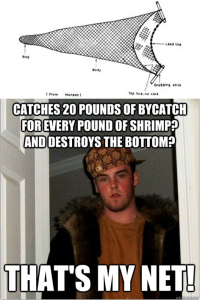
Bycatch is everything that fishermen catch that they weren’t trying to catch, including commercially valuable species that can be sold along with target catch as well as less valuable species that are dumped overboard. As modern industrial fishing gear can be extremely non-selective, some level of bycatch is unavoidable. The term for reducing bycatch (via technology or policy) is “bycatch mitigation”. To learn more about bycatch, visit Bycatch.org.
2) CPUE.
CPUE definition: “catch-per-unit-effort: a measure of the catch rate of a species standardized for the amount of fishing effort put into catching it” (Ref 1)
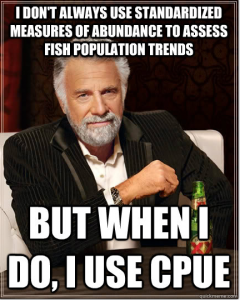
CPUE is standardized (by unit of effort) so you can tell if there’s been an actual decrease in how many fish were caught and be somewhat sure that it isn’t just an artifact of less fishing. For example, if you catch 50 sharks on 1,000 hooks one year and 48 sharks on 850 hooks the next year, you caught fewer sharks (50 -> 48), but have a higher CPUE (0.05 -> 0.056). While commonly used, many fisheries scientists argue that this is an overly simplistic assessment of stock health.
3) EEZ (vs. High Seas).
EEZ definition: “Exclusive Economic Zone: A zone under national jurisdiction (up to 200-nautical miles wide) declared in line with the provisions of 1982 United Nations Convention of the Law of the Sea, within which the coastal State has the right to explore and exploit, and the responsibility to conserve and manage, living and non-living resources” (Ref 1)
High Seas definition: ” International waters, beyond the EEZ boundaries that mark the territorial waters of coastal states” (Ref 1)
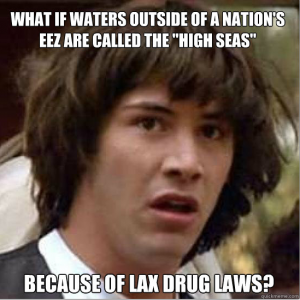
4) Extinction (vs. local extinction and extirpation)
Extinction definition: ” (Biological) extinction is the complete disappearance of a species from the Earth” (Ref 1)
Local extinction definition: ” the loss of the last individual of a particular species from a particular region or area” (Ref 1)
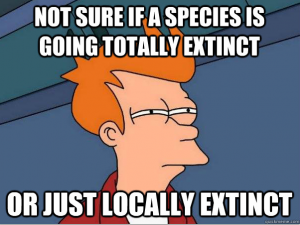
UPDATED Extirpation definition: “Extirpation is a term usually reserved to describe extinction from part of a species’ former range…this usage, while widespread, is incorrect. Instead…local extinction might be preferred. Strictly speaking, extirpation is described as the intentional eradication of a species” (Ref 5).
5) Finning.
Finning definition: “the practice of slicing off a shark’s fins and discarding the body at sea” (Ref 1)

We’ve discussed this at great length here on Southern Fried Science. If the body isn’t separated from fins and discarded at sea, it isn’t finning.
6) Finning bans, fin to carcass ratios, and fins naturally attached.
Finning bans are the colloquial term for policies ” designed to ensure that carcasses are not disposed of at sea while fins are retained” (Ref 2). This goal can be accomplished via either a “fin to carcass ratio” or a “fins naturally attached” policy.
Fin to carcass ratio definition: “As a compromise, some countries permit fishers to remove fins from bodies at sea for separate storage if the bodies are kept and the mass of fins on board a vessel corresponds, via a pre-established fin-to-body-mass ratio, to the mass of carcasses present” (Ref 3). A typical ratio is 5% (i.e. the weight of fins landed cannot be more than 5% of the weight of carcasses landed). The actual ratio of fin weight to body weight varies widely by species and by fin removal technique, which can allow some “cheating” (i.e. landing more fins than associated carcasses). For more on fin to carcass ratios, please see Chuck’s post on the topic.
Fins naturally attached policies require fishermen to land sharks without first removing the fins. This is widely considered to be the best practice, as it doesn’t allow cheating and makes it relatively easy for managers to determine how many individuals of each species have been killed.
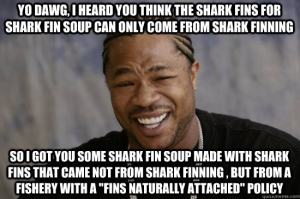
7) Fin bans.
“Fin bans”, another colloquial term, do not currently appear in the scientific or technical literature, but can be simply defined as making it illegal to buy, sell, or possess shark fins within the political boundaries covered by the law. Also called “blanket bans”, these policies ban fins regardless of their source. Specifics of these policies can vary widely. A recently proposed law sought to ban importation of shark fins from countries with poor regulations into Canada, while allowing consumption of domestically-caught fins, but this proposal failed to pass.
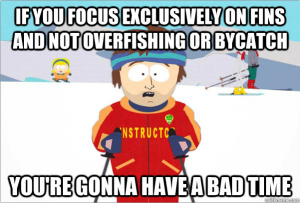
8 ) IPOA sharks/ NPOA sharks.
IPOA sharks definition: “United Nations Food and Agriculture Organization International Plan of Action for the Conservation and Management of Sharks” (Ref 1).
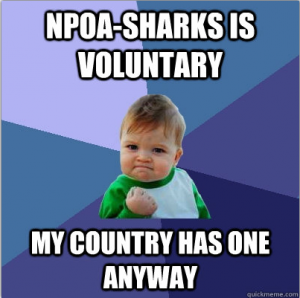
The IPOA sharks is a set of 10 principles that any NPOA-sharks (National Plan of Action for Shark Conservation and Management) should incorporate. They include ensuring sustainability of catches, monitoring the health of populations, providing special attention to threatened species, minimizing bycatch, encouraging full use of dead sharks, and encouraging countries to report their catch at the species level.For more information about the IPOA sharks principles, please visit this website. Most currently available NPOA-sharks can be accessed here.
9) IUCN (including Red List, Shark Specialist Group).
IUCN definition: “International Union for Conservation of Nature. A union of sovereign States, government agencies and non-governmental organisations.” (Ref 1)
IUCN Red List definition: ” listing of the conservation status of the world’s flora and fauna, administered by IUCN” (Ref 1). NOTE: Red List categories are capitalized, i.e. “Vulnerable”, “Critically Endangered”, etc.
IUCN Shark Specialist Group (SSG) definition: “The IUCN SSG is a group of ~160 experts from 12 regional groups (roughly reflecting FAO fishing areas) in the fields of shark biology, conservation, management, fisheries and taxonomy connected by their joint goal to promote the sustainable use, wise management and conservation of all sharks, rays and chimaeras. [our mission is] to promote the long-term conservation of the world’s sharks and related species (the skates, rays and chimaeras), effective management of their fisheries and habitats, and, where necessary, the recovery of their populations” (Source: IUCN SSG website)
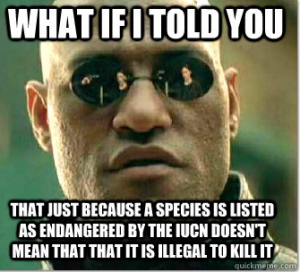
To learn more about the IUCN, the IUCN Shark Specialist Group, or the IUCN Red List please visit their websites.
10 ) Marine Protected Areas (i.e. MPA, vs. Shark Sanctuaries) .
MPA definition: “Marine Protected Area. Any area of the intertidal or subtidal terrain, together with its overlying water and associated flora, fauna, historical and cultural features, which has been reserved by law or other effective means to protect part or all of the enclosed environment”. While MPAs are commonly used interchangeably with “no-take marine reserves”, these no-take reserves, areas where no fishing is permitted, are the strictest of many types of MPA.
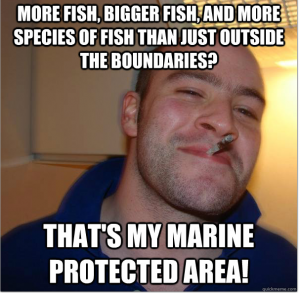
Shark Sanctuaries have yet to be defined in the scientific or technical literature, but can be defined here simply as (usually) large areas, up to and including a country’s entire EEZ, in which commercial shark fishing is banned. Unlike in strict no-take marine protected areas, fishing for other species is permitted, and in some shark sanctuaries, some fishing of sharks for personal consumption is permitted. As with “fin bans”, specific regulations can vary widely between shark sanctuaries.
11) Maximum Sustainable Yield (vs. quota)
MSY definition: “Maximum sustainable yield. The largest theoretical average catch or yield that can continuously be taken from a stock under existing environmental conditions without significantly affecting the reproductive process” (Ref 1)
Quota/Total Allowable Catch definition: “The amount of fish permitted to be taken from a population within a specified time period (usually a year) by all fishing vessels; designated by a regulatory authority, based (at least in theory) on scientific advice for sustainable removals.” (Ref 1)
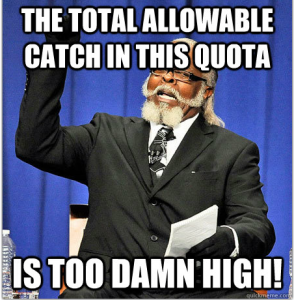
It is important to note that MSY is the highest value calculated by scientists that fishermen can remove without negatively impacting the stock, while the quota/TAC is what fishermen are actually legally allowed to remove. Quotas are usually set in terms of weight rather than number of animals removed and should vary over time depending on the best currently available scientific advice.
12) Pelagic (vs. demersal)
Pelagic definition: “occurring or living in open waters or near the water’s surface with little contact with or dependency on the sea floor” (Ref 1)
Demersal definition: “occurring or living near or on the bottom of the ocean” (Ref 1).

Demersal and pelagic species generally have different behaviors, and interact with different types of fishing gear. Pelagic species are more likely to be highly migratory and pass between political boundaries.
13) Population (vs. subpopulation, species and stock).
Population definition: “a group of individuals of a species living in a particular area. This is defined by IUCN (2001) as the total number of mature individuals of the taxon, with subpopulations defined as geographically or otherwise distinct groups in the population between which there is little demographic or genetic exchange (typically one successful migrant individual or gamete per year or less)”.(Ref 1)
Subpopulation definition: “geographically or otherwise distinct groups in a population between which there is little exchange” (Ref 1)
Stock definition: “a population or group of populations subject to actual or potential utilization, and which occupy a well defined geographical range independent of other populations of the same species. Usually regarded as an entity for fisheries management and assessment“ (Ref 1).
Species definition: “group of interbreeding individuals with common characteristics that produce fertile (capable of reproducing) offspring and which are not able to interbreed with other such groups, that is, a population that is reproductively isolated from others” (Ref 1)

Note that if a population or subpopulation reaches zero individuals, it is extirpated but not extinct, but if a species reaches zero individuals that species is extinct. Fisheries managers are generally concerned with the stock level, while conservationists are generally concerned with the species or population level. A population may include several stocks, or a stock may include several populations or subpopulations. The Endangered Species Act also sometimes covers subpopulations and not whole species. The IUCN Red List assessments sometimes work with any of several of these levels. Got it?
14) Regional Fisheries Management Organization (RFMO).
RFMO definition: ” Regional Fisheries Management Organisation. An intergovernmental body responsible for developing and implementing fishery management and regulations for international waters” (Ref 1)
Perhaps the best known RFMO is ICCAT, but there are many. Though none exist specifically to address shark fisheries, many have shark policies because they also have the responsibility of managing “tuna-like species”.
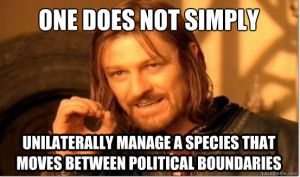
15) Sustainable (and overfished vs. overfishing).
Sustainable definition: “Fishing can be sustainable at many levels. Low levels of fishing effort result in small sustainable catches while the population remains large compared with its initial size. High levels of fishing can result in a similarly small sustainable catch but the population size is small and the labour and other costs of taking the catch are much higher… The highest sustainable catches are obtained somewhere in between low and high levels of fishing. If the level of fishing effort is very high, such that total mortality rate exceeds the reproductive rate, the population will continue to decline until it is uneconomic to continue fishing or until the population collapses.” (Ref 4)
Overfished definition: “When the population is too low, or below a prescribed threshold” (via NOAA). For those of you who prefer a mathematical formula to oversimplified text, this is when B/Bmsy <1 (actual biomass is less than the ideal biomass for generating maximum sustainable yield).
Overfishing definition: “When the rate of removal from stock is too high.” (via NOAA). A more technical definition is F/Fmsy > 1 (the actual fishing mortality is greater than the fishing mortality that would result in maximum sustainable yield).
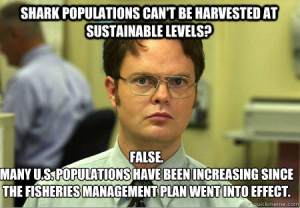
In case you didn’t follow that, sustainable simply means that you are taking fewer individuals out of the population than are naturally replaced via reproduction. This is a definition for “ecological sustainability” only and doesn’t consider either economic or social factors.
It’s also important to note that a stock can be experiencing overfishing without being overfished, or can be overfished without currently experiencing overfishing. Many shark populations are overfished with overfishing still occurring, while others are overfished or experiencing overfishing, and still others are neither overfished nor experiencing overfishing. A population that is being fished at a sustainable level will likely have a population size much less than before it was fished, because populations can be most productive when they are somewhat depleted.
Please note that these are not my definitions or my opinions, but a brief summary of some of the best available explanations from the scientific and technical literature. If anyone has an alternative definition for any of these terms that comes from the scientific or technical literature, please provide it in the comments along with relevant citation information, and feel free to ask if anything needs to be further clarified. I hope that this helps clear up some of the confusion and misconceptions about important shark conservation and management terms!
References
1) The conservation status of pelagic sharks and rays. IUCN Shark Specialist Group report, 2007.
2) Clarke (2013) Population trends in Pacific Oceans sharks and the utility of regulations on shark finning
3) Biery, L and Pauly, D (2012) A global review of species-specific shark-fin-to-body-mass ratios and relevant legislation.
4) Walker 1998 Can shark resources be harvested sustainably? A question revisited with a review of shark fisheries
5) Dulvy, N.K. and Forrest, R.E. (2009) Life histories, population dynamics, and extinction risks in chondrichthyans. In: Sharks and Their Relatives II: Biodiversity, Adaptive Physiology, and Conservation. (eds J.C. Carrier, J.A. Musick and M.R. Heithaus). CRC Press, Boca Raton. pp. 635-676.
It would be interesting to look at some of the legal definitions of these terms. Bycatch could also be defined as “fish you are not licensed to catch” #tongueplacedfirmlyincheek
I do not think your definition of reserve is correct. Sure, someone at sometime probably had an idea that a marine reserve would be no-take, but google “fishing reserve” and see what you find. People have very different reasons for reserving something. I’ve worked on creating marine protected areas and in my experience the name of something is meaningless, the definition comes from the regulations.
Your shark sanctuary definition is incorrect. Legally, all of them are national fishing regulations, or bycatch mitigation policies, not area closures. They are communicated as “parks” to the public because the public understands that.
Re: Marine Reserves, this is the definition I use:
“‘‘areas of the ocean completely protected from all extractive and destructive activities,’’ fully protected marine reserves (hereafter, simply ‘‘marine reserves’’)” From Lubchenco et al. 2003, PLUGGING A HOLE IN THE OCEAN: THE EMERGING SCIENCE OF
MARINE RESERVES.
To be sure, some things have been called marine reserves that don’t fit this definition, but I’d argue that those have incorrectly been called
Re: shark sanctuaries, an area closure can be part of a national fishing regulation, no? Are shark sanctuaries not parts of a country’s EEZ (or the whole EEZ) where some kinds of shark fishing isn’t allowed? Are they not defined spatially as well as by what’s allowed in that space? It’s more complicated than my simplified definition here, but is it not a reasonable proxy in the absence of a more established technical definition? If not, how would you define it?
Just because Jane Lubchenco wants to define something someway, does not make it legally so. Your definition of MPA is better, and then you should note that there are synonyms. #thisargumentwillleadusnowhere
The shark sanctuaries are only defined spatially in that national jurisdictions have limits, in this case the EEZ. If a country is defined as an area, then yes. I would define it as, “a shark sanctuary is a country that bans commercial shark fishing.”
At least several of these terms can have slightly different meanings depending upon the context.
For example, here’s the definition of bycatch as provided for under U.S. Law by Magnuson Steven’s Reauthorization Act of 2007:
“The term “bycatch” means fish which are harvested in a fishery, but which are not sold or kept for personal use, and includes economic discards and regulatory discards. Such term does
not include fish released alive under a recreational catch and release fishery management
program.” 16 USC 1802 Sec 3.
Compare that to ICCAT’s definition, under international law:
“Catch of species other than the intended target species in a fishing operation. Bycatch can either be dis-carded or landed.”
All (three) of these definitions have the same essence, yet vary slightly, at least from a legal perspective. The definitions you provide are a good starting point in helping rectifying common misunderstandings, but its important to keep in mind these are not necessarily the only valid definitions (or the legally accurate ones, as is the case with “bycatch”).
Certainly, there are slight variations in some definitions depending on the specific context you’re talking about. However, the larger point (that there are specific, technical definitions for these words and lots of people are just making up their own) stands.
hmmm…well, we all know that science and policy do not connect anyway! #tonguelooselyhangingoutofcheek – so since “sanctuary” has numerous definitions, is it a fair argument or to purport that sharks have a right to go somewhere sacred for prayer? I’ve certainly seen many a comment suggesting so in many a petition #godblesstheirsouls – and it is my observation that religion and policy seem to “connect” better (with little to no paperwork).
Recently, the Institute for Ocean Conservation Science (in a letter to a science magazine editor) described shark sanctuaries to be; “most commonly in the form of a moratorium on both commercial shark fishing and the export of shark products in Exclusive Economic Zones.” – and – “There is cause for optimism about the conservation potential of well-enforced shark sanctuaries nested within broader international management efforts.”
Bringing some things to mind…
It makes sense to me that definitions of any one or all possible “titles” for marine – sanctuaries; reserves; parks; protected areas; zones – would be devised via combination of a nations’ own scientific and legal interpretations (of perhaps their own previously implemented areas), and/or then separately or in combination with other nations’ scientific and legal frameworks together with international frameworks (i.e; UNESCO and UNFAO – of which even those can be found to have conflicting or confusing terminologies).
As Rob (and David) have pointed out – bycatch could similarly be confused/misconstrued.
David prescribes; “it’s absolutely vital to use proper terminology” … “to make sure everyone is speaking the same language”.
I suggest that those capable of researching, interpreting and communicating well, should visit the websites and corresponding web-pages for each regional, state or local fishery they intend to contact, as well as where needed, the departments of marine or environment or conservation (however it termed by that nation or state) – and then follow/use those definitions…
otherwise – just stick with “god save our sharks and oceans” (and keep praying).
And here I always thought ‘bycatch’ was what you say to a fish you have caught when you release it back into the sea! Doh!
Hi David, I found your posts today and I am really enjoying to read and learn more about sharks. I was looking for someone who could help me with something, maybe you could. I am really interested in finding information about shark feeding for recreational diving.
I think that subject is very sensitive and there is a big discussion whether it is good or not. however, I do believe that is not in the best interest of the sharks to be fed in an area with vague or nonexistent laws against the fishing and spearing of the sharks. I am trying to find some data or research to support this, in order to promote more strict laws and regulations against both the fishing and the feeding of the sharks in my region. I will appreciate enormously any help that you can give me. Thank you very much
Hi, Elena! As with most practices, shark feeding can sometimes be bad if done correctly. Most research that I’m aware of focuses on behavioral and physiological effects on the sharks that are fed, however, and not on how these practices interact with fishing regulations. Shoot me an e-mail (WhySharksMatter AT Gmail DOT com) and I can try to answer your question